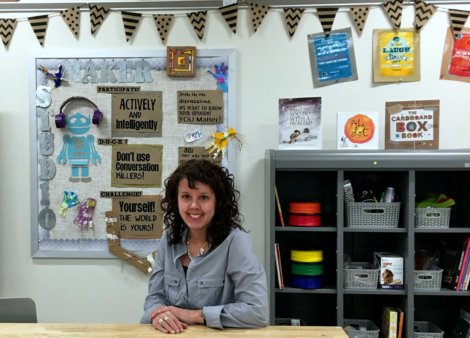
Thoughts, Tips, and Tricks from Future CBEs – Part 2
Posted by cemignano on
Last week we shared some discussion highlights from our online Certified BrainPOP Educator course. We’re excited to continue the series with more thoughts and ideas from our future CBEs. As part of the online course, we take a deep dive into game-based learning and explore BrainPOP’s playful assessment tools like Time Zone X and SnapThought. Participants are assigned a specific SnapThought game and are asked to play as if they’re students. They’re then tasked with playing Time Zone X with a partner to observe the benefits of partner play in the classroom. Here’s what our future CBEs have to say about BrainPOP’s playful assessment tools.
SnapThought in Action
“Learning tools like SnapThought allow the learner to reflect on the game they are playing and think about what they are learning. Often, online learning games focus on developing proficiency in basic skills and lack the reflection component. When given time to reflect on the game, the student is more likely to retain the information they learned from the game. SnapThought also gives the learner the opportunity to share with their teacher their thoughts on what they are learning. The ability for the student and teacher to communicate with each other through the SnapThought tool provides unique and individualized opportunities for learning that the student & teacher may not have had in a traditional classroom environment.” -Kathleen Weil
“This tool helps make students’ thinking visible and tangible: they can take a visual and write something that is meaningful at the time (something they figured out, a mistake to iterate from, their understanding, their success…). The teacher can ask the students to take a snapshot in the beginning and ask them to think about what could happen next (they inquire, make assumptions, use their imagination…). Also, their assumption can be wrong but then it becomes an opportunity to reflect! Explaining your thinking is not easy but it’s a skill that is required and this tool helps practice this skill.” – Fanny Passeport
“I’m really excited about implementing the SnapThought tool. If I assign a game, I’m always wondering if the students learned anything about the concept or idea I am trying to teach. I want to know if the game is an effective tool, and that it was beneficial and not just a filler for when the movie is done. I also want to know what my students are thinking, and a quiz doesn’t always show that. I want to know if there are misconceptions, and how I can help redirect their learning. I think that it will also help the students take a step back and absorb their learning. Reflection will also help them review ideas and test what they know. I can also use it as a formative assessment.” -Kena Pinedo
“SnapThought is great way to increase learning through games because of it’s promotion of metacognition- students are encouraged to think about their thinking (reflect). It’s also a wonderful opportunity to allow students to communicate. In watching these videos, it reiterated the idea of giving students a unique voice. By this I mean, so often there seems to be “one” way or the “right” way in terms of content- however, with SnapThought students are able to communicate their findings and justify their reasoning and rationale to promote “out-side-of-the-box” ideas.” – Sarah Webster
“The SnapThought tool is a great way for students to reflect on their learning process, synthesize ideas and communicate thought processes with others (teacher). I love the idea of students giving a “Picto Think Aloud” of their new understandings. This give the teacher the opportunity to provide feedback, clear up misconceptions and clarify understandings while differentiating support as needed as students gain and practice new learning.” -Jessie Erickson
Valuable Takeaways from TimeZone X
“So I made my 12 year old son, Max, play Time Zone X with me. We decided on Architecture because he loves that topic. I am going to admit that he rocked the assignment and I might have held him back. The discussion back and forth was incredible and one I would hope to see in a classroom. It allowed for us the challenge each other’s thinking and ask why. It seems like each time I asked, why would you put it there, Max’s reasoning was spot on looking closely at clues and years. I clearly found out that I am not smarter than a 7th grader! We did however have great discussion and worked on our problem solving skills. Can’t wait to introduce this tool to my teachers!” – Samantha Knoll
“During the game I had to carefully examine the screens to better understand what I needed to do. The game was far harder if I did not read the full text of each “topic”. My students like to guess and check and that strategy is really ineffective in TZX. We practiced putting things in chronological order and we also found ourselves looking at the topics to see if it was making a logical progression. For example, a law passing would come before its repeal. This also caused us to use the vocabulary associated with the topic throughout the lesson and ultimately persuade one another of our thinking. Socially I would be really happy too if my students made their points and worked together without getting angry or raising their voices. We will rehearse how to solve problems when you play with a partner and disagree before we begin playing in groups.” – Greg Kocourek
“Once I realized that this was a timeline/historical events game I knew my husband would be a rock star because this is just up his alley and was his major in college so I knew that I needed to “step my game up”.
Academic skills that were present during this playful assessment were: oral language, vocabulary, writing, and making predictions.
Oral language or having a discussion with your partner allows the teacher to have earlier lessons on being respectful to others opinions, making eye contact and responding in kind ways if you disagree on an item or choice. Vocabulary played a huge role in this game because you had to really dissect the description each tile they gave you. Writing was used when taking a snapshot of what you felt needed clarification and this game also was all about making academic predictions of where each tile would go next.” – Melissa Murray
“I played Time Zone X with my daughter who is in 7th grade. We chose to play the American Revolution because she is studying it in class. I liked the conversation we had to figure out where the cards should be placed. We looked for important dates and names and then she recalled facts from other media sources she had experienced in class. A few times we placed a card wrong and then after talked a bit about why that didn’t work. We were able to see the wrong in our thinking and reflect back on facts that should have helped us in the placing of the cards.” – Suzanne Gudjonis
Be sure to visit the blog later this month for even more ideas from future CBEs!














